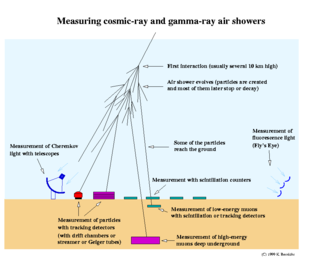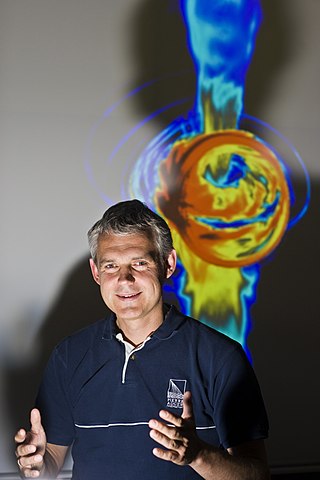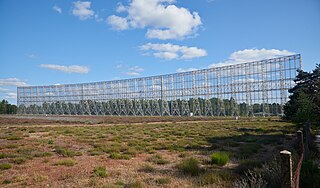
Cosmic rays or astroparticles are high-energy particles or clusters of particles that move through space at nearly the speed of light. They originate from the Sun, from outside of the Solar System in our own galaxy, and from distant galaxies. Upon impact with Earth's atmosphere, cosmic rays produce showers of secondary particles, some of which reach the surface, although the bulk are deflected off into space by the magnetosphere or the heliosphere.

Air showers are extensive cascades of subatomic particles and ionized nuclei, produced in the atmosphere when a primary cosmic ray enters the atmosphere. Particles of cosmic radiation can be protons, nuclei, electrons, photons, or (rarely) positrons. Upon entering the atmosphere, they interact with molecules and initiate a particle cascade that lasts for several generations, until the energy of the primary particle is fully converted. If the primary particle is a hadron, mostly light mesons like pions and kaons are produced in the first interactions, which then fuel a hadronic shower component that produces shower particles mostly through pion decay. Primary photons and electrons, on the other hand, produce mainly electromagnetic showers. Depending on the energy of the primary particle, the detectable size of the shower can reach several kilometers in diameter.

The Low-Frequency Array (LOFAR) is a large radio telescope, with an antenna network located mainly in the Netherlands, and spreading across 7 other European countries as of 2019. Originally designed and built by ASTRON, the Netherlands Institute for Radio Astronomy, it was first opened by Queen Beatrix of The Netherlands in 2010, and has since been operated on behalf of the International LOFAR Telescope (ILT) partnership by ASTRON.
The High Resolution Fly's Eye or HiRes detector was an ultra-high-energy cosmic ray observatory that operated in the West Desert of Utah from 1981 until April 2006. HiRes used the "atmospheric fluorescence" technique that was pioneered by the Utah group first in tests at the Volcano Ranch experiment and then with the original Fly's Eye experiment. The experiment first ran as the HiRes prototype in a tower configuration operating in conjunction with the CASA and MIA. The prototype was later reconfigured to view 360 degrees in azimuth. HiRes-II followed later and was located on a hilltop about 13km away. HiRes-I and HiRes-II operated in stereo. In 1991 it discovered the Oh-My-God Particle.

The Pierre Auger Observatory is an international cosmic ray observatory in Argentina designed to detect ultra-high-energy cosmic rays: sub-atomic particles traveling nearly at the speed of light and each with energies beyond 1018 eV. In Earth's atmosphere such particles interact with air nuclei and produce various other particles. These effect particles (called an "air shower") can be detected and measured. But since these high energy particles have an estimated arrival rate of just 1 per km2 per century, the Auger Observatory has created a detection area of 3,000 km2 (1,200 sq mi)—the size of Rhode Island, or Luxembourg—in order to record a large number of these events. It is located in the western Mendoza Province, Argentina, near the Andes.
LORUN stands for LOFAR at Radboud University Nijmegen. It is a radio telescope based on antennas designed for the THETA test station for the LOFAR radio telescope. This project is also closely related to the LOPES Project, it uses the data acquisition program originally designed for LOPES.

IACT is a device or method to detect very-high-energy gamma ray photons in the photon energy range of 50 GeV to 50 TeV.

The Antarctic Impulsive Transient Antenna (ANITA) experiment has been designed to study ultra-high-energy (UHE) cosmic neutrinos by detecting the radio pulses emitted by their interactions with the Antarctic ice sheet. This is to be accomplished using an array of radio antennas suspended from a helium balloon flying at a height of about 37,000 meters.
The Askaryan radiation also known as Askaryan effect is the phenomenon whereby a particle traveling faster than the phase velocity of light in a dense dielectric produces a shower of secondary charged particles which contains a charge anisotropy and emits a cone of coherent radiation in the radio or microwave part of the electromagnetic spectrum. The signal is a result of the Cherenkov radiation from individual particles in the shower. Wavelengths greater than the extent of the shower interfere constructively and thus create a radio or microwave signal which is strongest at the Cherenkov angle. The effect is named after Gurgen Askaryan, a Soviet-Armenian physicist who postulated it in 1962.
KASCADE was a European physics experiment started in 1996 at Forschungszentrum Karlsruhe, Germany, an extensive air shower experiment array to study the cosmic ray primary composition and the hadronic interactions, measuring simultaneously the electronic, muonic and hadronic components.

A cosmic-ray observatory is a scientific installation built to detect high-energy-particles coming from space called cosmic rays. This typically includes photons, electrons, protons, and some heavier nuclei, as well as antimatter particles. About 90% of cosmic rays are protons, 9% are alpha particles, and the remaining ~1% are other particles.
The Washington Area Large-scale Time-coincidence Array (WALTA) is a cosmic ray physics experiment run by the University of Washington to investigate ultra high energy cosmic rays (>1019eV). The program uses detectors placed at Seattle-area high schools and colleges which are linked via the internet, effectively forming an Extensive Air Shower array. In addition to working on the unexplained levels of Ultra High Energy cosmic ray (UHECR) flux, it hopes to serve as a pedagogical tool for increasing the physics involvement of high schools and community colleges with a University level physics experiment. Each site has three to four scintillation detectors with the goal of having enough sites to cover a 200 km2 area around the city of Seattle. WALTA is a part of the larger NALTA project which hopes to combine data from several WALTA like projects to further the exploration of UHE cosmic rays.
The Askaryan Radio Array (ARA) is a new detector designed to detect a few GZK neutrinos a year. It measures the enhanced radio-frequency radiation emitted during the interaction of the neutrino in Antarctic ice sheet. The detection is based on the Askaryan effect, an idea by Gurgen Askaryan
The Long Wavelength Array (LWA) is a radio telescope in central New Mexico. It began preliminary tests of the hardware in 2011, and began regular operations in late 2015. It is one of the few observatories to utilize relatively low frequencies (10-88 MHz), and is used to study relativistic particles, cosmic evolution, astrophysical plasma, decametric radio emissions from Jupiter-like extrasolar planets, and giant flares from magnetars.
The Tunka experiment now named TAIGA measures air showers, which are initiated by charged cosmic rays or high energy gamma rays. TAIGA is situated in Siberia in the Tunka valley close to lake Baikal. Meanwhile, TAIGA consists of five different detector systems: Tunka-133, Tunka-Rex, and Tunka-Grande for charged cosmic rays; Tunka-HiSCORE and Tunka-IACT for gamma astronomy. From the measurements of each detector it is possible to reconstruct the arrival direction, energy and type of the cosmic rays, where the accuracy is enhanced by the combination of different detector systems.

Very-high-energy gamma ray (VHEGR) denotes gamma radiation with photon energies of 100 GeV (gigaelectronvolt) to 100 TeV (teraelectronvolt), i.e., 1011 to 1014 electronvolts. This is approximately equal to wavelengths between 10−17 and 10−20 meters, or frequencies of 2 × 1025 to 2 × 1028 Hz. Such energy levels have been detected from emissions from astronomical sources such as some binary star systems containing a compact object. For example, radiation emitted from Cygnus X-3 has been measured at ranges from GeV to exaelectronvolt-levels. Other astronomical sources include BL Lacertae, 3C 66A Markarian 421 and Markarian 501. Various other sources exist that are not associated with known bodies. For example, the H.E.S.S. catalog contained 64 sources in November 2011.
Cosmic Ray Energetics and Mass (CREAM) is an experiment to determine the composition of cosmic rays up to the 1015 eV (also known as the "knee prospect") in the cosmic ray spectrum.

Heino Falcke is a German professor of radio astronomy and astroparticle physics at the Radboud University Nijmegen (Netherlands). His main field of study is black holes, and he is the originator of the concept of the 'black hole shadow'. In 2019, Falcke announced the first Event Horizon Telescope results at the EHT Press Conference in Brussels.

The Nançay Radio Observatory, opened in 1956, is part of Paris Observatory, and also associated with the University of Orléans. It is located in the department of Cher in the Sologne region of France. The station consists of several instruments. Most iconic of these is the large decimetric radio telescope, which is one of the largest radio telescopes in the world. Long established are also the radio heliograph, a T-shaped array, and the decametric array operating at wavelengths between 3 m and 30 m.
The Giant Radio Array for Neutrino Detection (GRAND) is a proposed large-scale detector designed to collect ultra-high energy cosmic particles as cosmic rays, neutrinos and photons with energies exceeding 1017 eV. This project aims at solving the mystery of their origin and the early stages of the universe itself. The proposal, formulated by an international group of researchers, calls for an array of 200,000 receivers to be placed on mountain ranges around the world.









